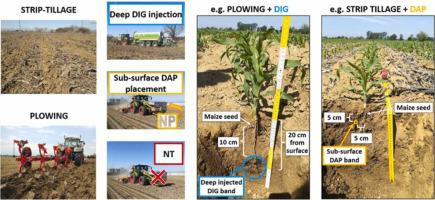European Journal of Agronomy ( IF 4.5 ) Pub Date : 2022-05-24 , DOI: 10.1016/j.eja.2022.126534 Michela Battisti , Laura Zavattaro , Luca Capo , Massimo Blandino

|
An early maize (Zea mays L.) sowing date plays a key role in increasing the grain yield, especially in a temperate climate. The adoption of reduced tillage techniques, such as strip tillage (ST), can decrease cultivation costs, compared to plowing (PLOW), but might also reduce the crop early development rate as a result of lower soil temperatures. Therefore, farmers often adopt starter fertilizations when sowing maize, in order to improve the early-season nutrient uptake, nutrient use efficiency and plant development. The aims of this study were to assess the effects of the adoption of ST, compared to PLOW, and a starter fertilization with deep-injected digestate (DIG) or sub-surface placed diammonium phosphate (DAP), compared to an unfertilized treatment (NT) on the early growth, grain yield and grain qualitative and sanitary traits of maize. Field experiments were carried out in NW Italy over the 2019 and 2020 growing seasons on two different soils. ST determined cooler soil conditions at both sites, compared to PLOW, thus resulting in lower NDVI values due to both slower plant development and lower final crop density. The starter fertilization with DAP recorded the best early vigor and canopy development, expressed as plant height in both sites and for both tillage techniques, while the DIG values were intermediate between the DAP and NT treatments. Although the effects on the early vigor of maize differed between the experimental sites, displaying more pronounced differences in the finer-textured soil, ST on average delayed the flowering (+2.2 days) and consequently delayed the moisture dry down process (+1.2% grain moisture content at harvest), compared to PLOW. The starter fertilization with DIG or DAP led to an earlier flowering, compared to NT (−2.6 and −4.6 days, respectively). The grain yield was not affected by the tillage system, as the plants in ST compensated for the lower plant density with an increased ear length (+1.5%). Instead, DIG and DAP recorded similar and higher grain yields (+1.8 and +1.6 Mg ha−1) than NT. DIG application led to a higher grain protein content and lower level of fumonisin contamination than the other treatments, while ST determined higher deoxynivalenol values than PLOW. The combination of ST and DIG as a starter fertilization can help maintain the production level and the grain quality, compared to conventional techniques that involve the use of mineral fertilizers and plowing, thereby leading to a higher sustainability of the maize cropping system.
中文翻译:

不同土壤耕作方法下玉米对局部矿物或有机 NP 发酵剂施肥的响应
早熟玉米(Zea maysL.) 播种日期在提高粮食产量方面起着关键作用,尤其是在温带气候下。与耕作 (PLOW) 相比,采用减耕技术,例如条耕 (ST),可以降低耕作成本,但由于土壤温度较低,也可能会降低作物早期发育速度。因此,农民在播种玉米时常采用发酵剂施肥,以提高早季养分吸收、养分利用效率和植株发育。本研究的目的是评估采用 ST 与 PLOW 相比的效果,以及与未施肥处理(NT ) 对玉米的早期生长、籽粒产量和籽粒质量和卫生性状的影响。在 2019 年和 2020 年的生长季节,在意大利西北部在两种不同的土壤上进行了田间试验。与 PLOW 相比,ST 在两个地点确定了较冷的土壤条件,因此由于植物发育较慢和最终作物密度较低,导致 NDVI 值较低。DAP 的起始施肥记录了最好的早期活力和冠层发育,以两个地点和两种耕作技术的株高表示,而 DIG 值介于 DAP 和 NT 处理之间。尽管不同试验地点对玉米早期活力的影响不同,但在质地较细的土壤中表现出更明显的差异,但 ST 平均延迟开花(+2.2 天)并因此延迟水分干燥过程(+1.2% 谷物收获时的水分含量),与犁相比。与 NT(分别为 -2.6 和 -4.6 天)相比,使用 DIG 或 DAP 的起始施肥导致更早开花。谷物产量不受耕作系统的影响,因为 ST 中的植物通过增加穗长 (+1.5%) 来补偿较低的植物密度。相反,DIG 和 DAP 记录的粮食产量相似且更高(+1.8 和 +1.6 Mg ha-1 ) 比 NT。与其他处理相比,DIG 应用导致更高的谷物蛋白质含量和更低水平的伏马菌素污染,而 ST 确定的脱氧雪腐镰刀菌烯醇值高于 PLOW。与涉及使用矿物肥料和耕作的传统技术相比,ST 和 DIG 作为起始施肥的组合有助于维持生产水平和谷物质量,从而提高玉米种植系统的可持续性。











































 京公网安备 11010802027423号
京公网安备 11010802027423号